Sunday, 17 June, Napoleon and Joël
Written 6 July 2018
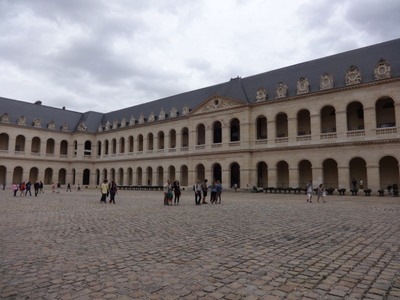
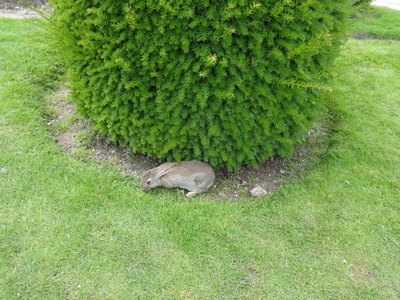 Back in 1670, Louis XIV had a hospital and residence built for disabled veterans, originally called l'Hôpital des Invalides, now mostly just called "Les Invalides." It's still there, and it's huge; it has (count 'em!) 15 interior courtyards. The largest courtyard is the Cour d'Honneur and is the setting of the finale of The Mad Adventures of Rabbi Jacob, the Louis de Funès movie mentioned in yesterday's entry. The photo at the left gives an idea of the size of the Cour d'Honneur, and that at the right of how tame the bunnies are that nibble the grass on the esplanade.
Back in 1670, Louis XIV had a hospital and residence built for disabled veterans, originally called l'Hôpital des Invalides, now mostly just called "Les Invalides." It's still there, and it's huge; it has (count 'em!) 15 interior courtyards. The largest courtyard is the Cour d'Honneur and is the setting of the finale of The Mad Adventures of Rabbi Jacob, the Louis de Funès movie mentioned in yesterday's entry. The photo at the left gives an idea of the size of the Cour d'Honneur, and that at the right of how tame the bunnies are that nibble the grass on the esplanade.
It's worth having a look at the beautiful aerial view in its Wikipedia entry. You can see not only the building and its surrounding wall and dry moat but the long esplanade leading from it down to the river, where its central avenue crosses over the Alexander III bridge (which I'm always going on about; definitely my favorite Parisian bridge) and passes between the Grand Palais on the left and the Petit Palais on the right, both of which I'll talk about in later entries.
One section of Les Invalides still houses disabled veterans, but the rest is given over to monuments and museums, most notably Napoleon's grandiose tomb and the army museum, which is so large that the basic ticket is good for two days.
We've been there several times, as a result of David's and, later, Dan Sinnett's, interest in things military and historical, and back in 2009, we spent a lot of time in the newly opened permanent exhibition on Charles De Gaulle (26 June blog entry), but our project for Sunday was to visit this summer's temporary exhibition called "Napoléon Stratège," i.e. "Napoleon, Strategist."
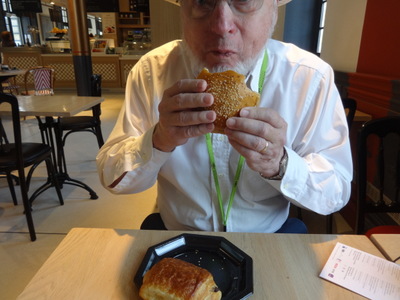
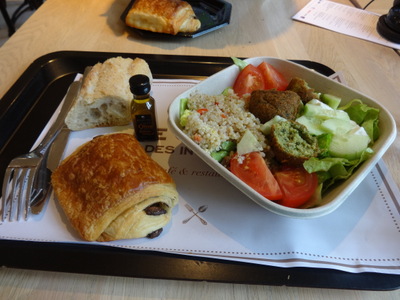 We got a leisurely start and took the #8 metro line, which conveniently led from near our apartment to a number of useful destinations, including this one, and got to the museum in time for an early lunch, which for convenience's sake, we got at the museum's lunch room. Because it was only about 11:30 a.m., they were still serving late breakfast and setting up for lunch, and the cashier rolled her eyes at the crazy Americans who ordered both sandwich and salad (clearly lunch) and pain au chocolate (in her view, breakfast and definitely not dessert).
We got a leisurely start and took the #8 metro line, which conveniently led from near our apartment to a number of useful destinations, including this one, and got to the museum in time for an early lunch, which for convenience's sake, we got at the museum's lunch room. Because it was only about 11:30 a.m., they were still serving late breakfast and setting up for lunch, and the cashier rolled her eyes at the crazy Americans who ordered both sandwich and salad (clearly lunch) and pain au chocolate (in her view, breakfast and definitely not dessert).
David picked out some sort of cold-cut sandwich, and I had quite a good "Mediterranean salad" featuring cold falafel, lettuce and tomato, cubes of feta, cucumber, and tabbouleh made with that good old Mediterranean staple, quinoa. Note the complete absence of nonrecyclable single-use plastics—metal flatware and a tiny glass bottle of balsamic vinaigrette.
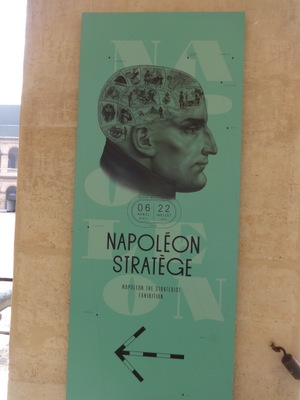
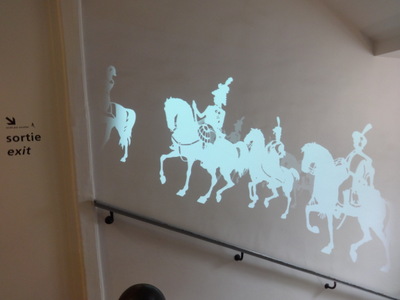 Then we headed to the exhibit, directed first by this large poster advertising it and then by these Napoleonic horsemen, which were projected on the walls of the stairwell and glided slowly and endlessly upward.
Then we headed to the exhibit, directed first by this large poster advertising it and then by these Napoleonic horsemen, which were projected on the walls of the stairwell and glided slowly and endlessly upward.
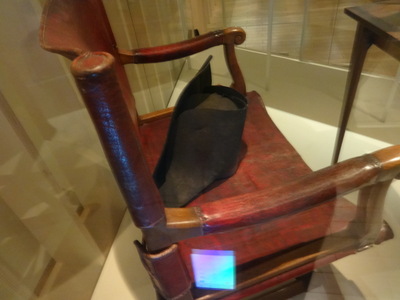
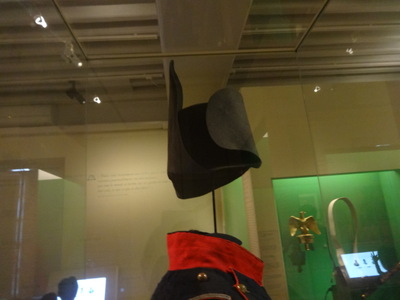 By and large, the exhibition wasn't very photogenic. I took lots of photos, but most of them are of text, charts, and quotations painted on the walls.
By and large, the exhibition wasn't very photogenic. I took lots of photos, but most of them are of text, charts, and quotations painted on the walls.
We did see some Napoleonic memorabilia, like these two hats, one on his camp chair and one on a stand above one of his uniforms, and I learned that he normally wore his hat like all the other officers, which one point in front and one behind, but that he always turned it sideways during battle, so that his troops could spot and identify him easily.
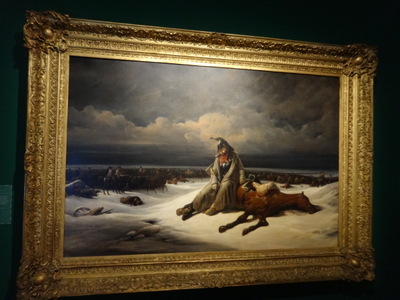
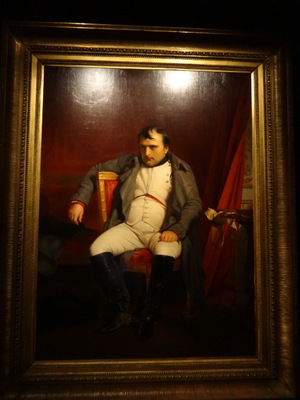 The painting at the right here depicts Napoleon at his nadir, when he had just learned of the unfortunate outcome at Waterloo.
The painting at the right here depicts Napoleon at his nadir, when he had just learned of the unfortunate outcome at Waterloo.
My photo of the label on the one at the right came out blurry, but I think it represents the fate of Napoleon's ill-fated troops in Russia—a cavalryman with a wounded foot is sitting, dejected, on his dead horse.
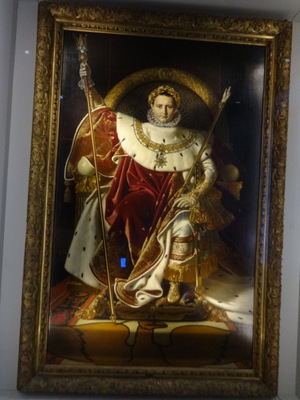
 And of course, they had hung the famous Ingres painting of Napoleon on the Imperial throne, but they also displayed this bust of Henri de La Tour d'Auvergne, vicomte de Turenne, usually just called "Turenne." He's the one portrayed as a child in the statue near our apartment, with his hand spray-painted pink.
And of course, they had hung the famous Ingres painting of Napoleon on the Imperial throne, but they also displayed this bust of Henri de La Tour d'Auvergne, vicomte de Turenne, usually just called "Turenne." He's the one portrayed as a child in the statue near our apartment, with his hand spray-painted pink.
Of him, Napoleon is quoted as saying (in my translation), "Of all the generals who have preceded me, and who perhaps will follow me, the greatest is Turenne."
The giftshop at the exit of the Napoleon exhibition included Napoleon children's books, metal toy soldiers, Napoleon rubber duckies, fuzzy models of Napoleon's horse, erasers of the bust of Napoleon, sewn fabric Napoleon and Josephine Christmas ornaments, Balzacs in paperback, blank books with Napoleon covers, and even Napoleon cologne!
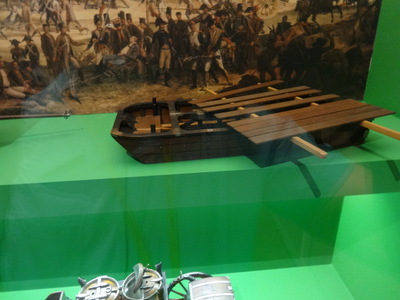
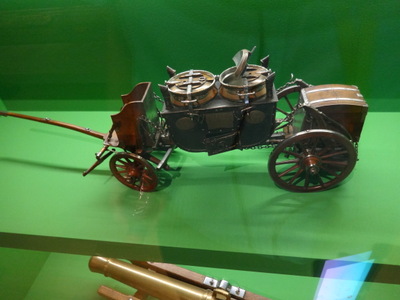 After we finished Napoleon, we didn't climb to the top to look again at the great architectural models in the attic, but rather than walking straight down the stairs, we walked once around the hallways on each floor. (In each section of the museum, the hallways form large squares, since they surround the courtyards.) In the hall of miniatures, I got this shot of a model of the kind of boats Napoleon used to throw temporary bridges over rivers. The boats traveled on sledges or on wheeled carts like gun carriages, and when needed they were lined up side by side all the way across the river, and these plank frames were assembled and laid across them to form a roadway.
After we finished Napoleon, we didn't climb to the top to look again at the great architectural models in the attic, but rather than walking straight down the stairs, we walked once around the hallways on each floor. (In each section of the museum, the hallways form large squares, since they surround the courtyards.) In the hall of miniatures, I got this shot of a model of the kind of boats Napoleon used to throw temporary bridges over rivers. The boats traveled on sledges or on wheeled carts like gun carriages, and when needed they were lined up side by side all the way across the river, and these plank frames were assembled and laid across them to form a roadway.
At the right is a wonderful little model of a field kitchen, with two large kettles set into a metal firebox and a trunk on the back for provisions.
I can't begin to list all the stuff there is to see in just that section—uniforms, maps, paintings, miniatures, military musical instruments, Napoleon's stuffed and mounted horse. It goes on forever.
Finally, just as we reached the bottom of the staircase and were preparing to leave, we were passed by two large busloads of the famous "sapeurs and pompiers," all clad in matching blue t-shirts who trooped in and started up the stairs toward Napoleon, and a fine, strapping lot they were! Are things like the army museum and the fair museum part of their training? Or do they just go on recreational outings from time to time? I have no idea.
For dinner, David had chosen l'Atelier de Joël Robuchon, Étoile. The "Étoile" (i.e. Place de l'Étoile, where the Arc de Triomphe is located) serves to distinguish it from the other one at Saint-Germain on the left bank and from all the others in cities around the world, like Hong Kong, LA, Montreal, Tokyo, and and Las Vegas. The one in Beirut is just a wine cellar and shop, rather than a full-scale "Atelier."
The place is located, for some reason, in the basement of the Publicis Drugstore, a glamourous emporium located on prime real estate right next to the Arc de Triomphe. It supposedly emulates American drugstores, which the French find an unending source of wonder. You tell a visiting French friend that you'll be stopping by the drugstore (which is always translated "pharmacie") on the way home, and when the two of you step inside, say, a Walgreens, the friend's jaw drops. Not like a French pharmacy at all! They sell everything here! It's like a wonderland! On the other hand, the Publicis Drugstore does not, to me, resemble an American drugstore at all—it's much more like a large airport duty-free shop (except, of course, for the prices).
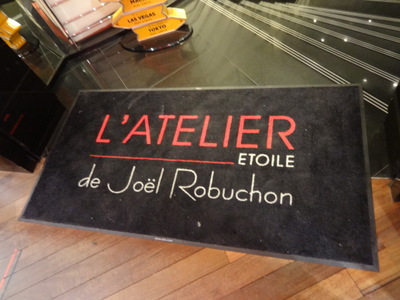
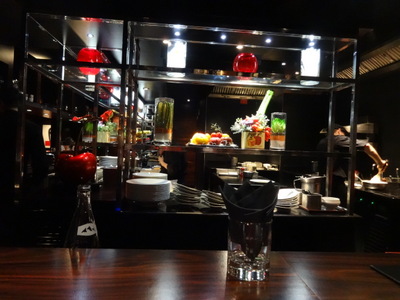 Anyway, Joël has set up shop in its basement. When I called for reservations (because, during the whole trip, the on-line reservation form used by French restaurants refused to recognize the validity of my French phone number; actually the phone number was fine, the software just wouldn't believe it was a French one), I was told that the dining room was booked up but that we could sit at the counter, looking into the kitchen. Yes, please!
Anyway, Joël has set up shop in its basement. When I called for reservations (because, during the whole trip, the on-line reservation form used by French restaurants refused to recognize the validity of my French phone number; actually the phone number was fine, the software just wouldn't believe it was a French one), I was told that the dining room was booked up but that we could sit at the counter, looking into the kitchen. Yes, please!
This doormat greeted us at the top of the stairs, and we sat facing the decorative shelves at the right during dinner. I was a little disappointed that the decorative food was fake, but I guess they have to keep costs down. The guy in the background at the right is beating up mashed potatoes (but not aligot).
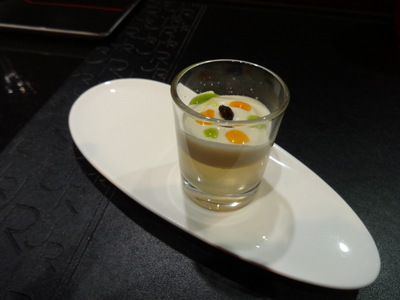
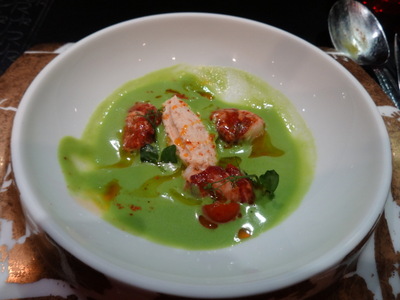 We ordered the tasting menu, so we ate all the same things. Alas, I also kept forgetting to photograph them before eating! Sorry 'bout that. Overall, this was one of the most pleasant meals of the whole trip, although one waiter, who was shorter than the others, found it very hard to reach over the raised backsplash on the counter to set our plates in front of us. He wouldn't move the glass full of cocktail napkins, even thought it was clearly in the way, and he wouldn't let us take the plates from him in mid-air. "No, no, it's my job!"
We ordered the tasting menu, so we ate all the same things. Alas, I also kept forgetting to photograph them before eating! Sorry 'bout that. Overall, this was one of the most pleasant meals of the whole trip, although one waiter, who was shorter than the others, found it very hard to reach over the raised backsplash on the counter to set our plates in front of us. He wouldn't move the glass full of cocktail napkins, even thought it was clearly in the way, and he wouldn't let us take the plates from him in mid-air. "No, no, it's my job!"
At the left is the amuse bouche, a clear lemon-vanilla jelly topped with an anise-flavored cream and a dab of caviare.
At the right the first course: cold lobster on a cold, mint-flavored green pea soup, with pea sprouts and drizzles of flavored oils.
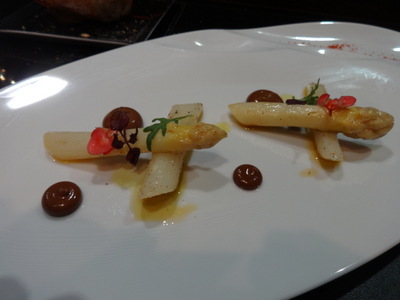
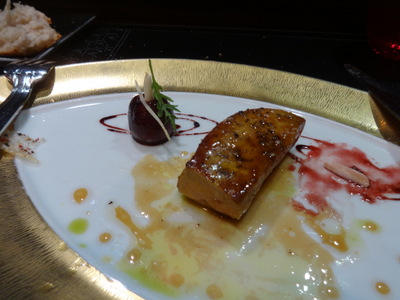 Second course: White asparagus on an emulsion of vegetables and miso, garnished with tiny shiso leaves. The pink things are lemony-flavored begonia blossoms.
Second course: White asparagus on an emulsion of vegetables and miso, garnished with tiny shiso leaves. The pink things are lemony-flavored begonia blossoms.
Third course: Sautéed duck foie gras with stewed black cherries and fresh almonds.
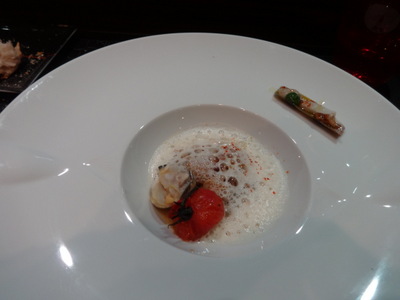
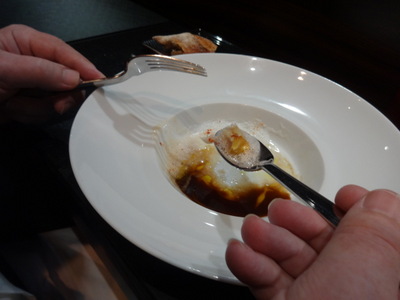 Fourth course: "Palourdes" (a kind of clam) and tiny chanterelles in an iodized broth with vermouth, garnished wtih a roasted cherry tomato and, on the edge of the plate, a single hummy razor clam.
Fourth course: "Palourdes" (a kind of clam) and tiny chanterelles in an iodized broth with vermouth, garnished wtih a roasted cherry tomato and, on the edge of the plate, a single hummy razor clam.
Fifth course: Black cod stewed with Malabar black pepper and baby spinach.
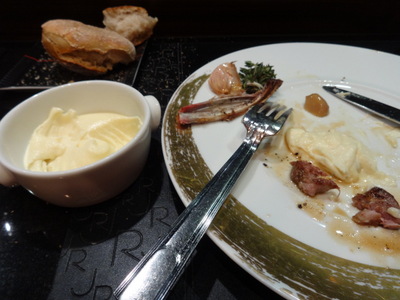
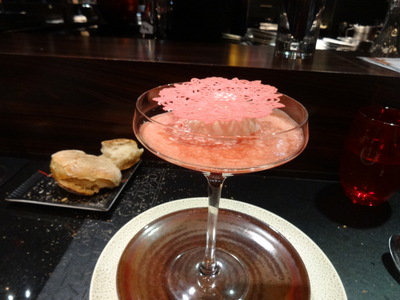 Sixth course: A choice between tiny baby lamb chops, sautéed with fresh thyme, and quail caramelized with apples. We both chose the lamb, which came wth the mashed potatoes we'd been seeing a cook beat up batches of all evening.
Sixth course: A choice between tiny baby lamb chops, sautéed with fresh thyme, and quail caramelized with apples. We both chose the lamb, which came wth the mashed potatoes we'd been seeing a cook beat up batches of all evening.
Seventh course: "Le Bubble Coco," which seemed to consist of coconut ice cream doused with pink champagne and garnished with cranberries and oranges. The flat thing balanced on top was an impossibly thin crisp cookie, tinted pink, and baked in some kind of very flat snowflake mold (unless it was baked as a thin sheet and laser cut . . .). A little alcoholic for me, but actually pretty good.
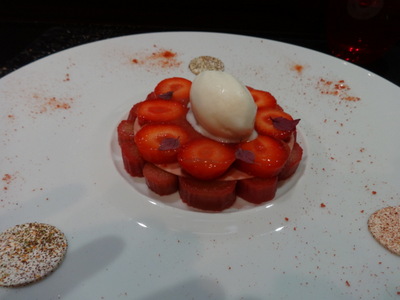
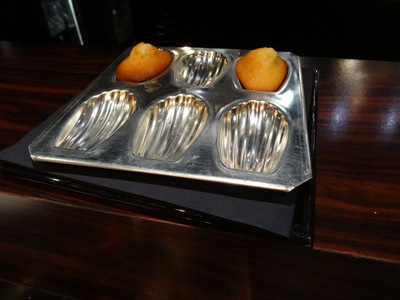 Eighth course: Rhubarb and gariguette strawberries with a "fromage blanc" sorbet and "caramelized crisped rice," which must have been the thin wafer that rested on top of the short rhubarb posts to support the strawberries. Why can't American growers grow strawberries like the ones you get in France?! The discs around the edge of the plate were crisp meringue.
Eighth course: Rhubarb and gariguette strawberries with a "fromage blanc" sorbet and "caramelized crisped rice," which must have been the thin wafer that rested on top of the short rhubarb posts to support the strawberries. Why can't American growers grow strawberries like the ones you get in France?! The discs around the edge of the plate were crisp meringue.
Mignardises: Madeleines, served in a madeleine pan.
Previous entry
List of Entries
Next entry

 Back in 1670, Louis XIV had a hospital and residence built for disabled veterans, originally called l'Hôpital des Invalides, now mostly just called "Les Invalides." It's still there, and it's huge; it has (count 'em!) 15 interior courtyards. The largest courtyard is the Cour d'Honneur and is the setting of the finale of The Mad Adventures of Rabbi Jacob, the Louis de Funès movie mentioned in yesterday's entry. The photo at the left gives an idea of the size of the Cour d'Honneur, and that at the right of how tame the bunnies are that nibble the grass on the esplanade.
Back in 1670, Louis XIV had a hospital and residence built for disabled veterans, originally called l'Hôpital des Invalides, now mostly just called "Les Invalides." It's still there, and it's huge; it has (count 'em!) 15 interior courtyards. The largest courtyard is the Cour d'Honneur and is the setting of the finale of The Mad Adventures of Rabbi Jacob, the Louis de Funès movie mentioned in yesterday's entry. The photo at the left gives an idea of the size of the Cour d'Honneur, and that at the right of how tame the bunnies are that nibble the grass on the esplanade.
 We got a leisurely start and took the #8 metro line, which conveniently led from near our apartment to a number of useful destinations, including this one, and got to the museum in time for an early lunch, which for convenience's sake, we got at the museum's lunch room. Because it was only about 11:30 a.m., they were still serving late breakfast and setting up for lunch, and the cashier rolled her eyes at the crazy Americans who ordered both sandwich and salad (clearly lunch) and pain au chocolate (in her view, breakfast and definitely not dessert).
We got a leisurely start and took the #8 metro line, which conveniently led from near our apartment to a number of useful destinations, including this one, and got to the museum in time for an early lunch, which for convenience's sake, we got at the museum's lunch room. Because it was only about 11:30 a.m., they were still serving late breakfast and setting up for lunch, and the cashier rolled her eyes at the crazy Americans who ordered both sandwich and salad (clearly lunch) and pain au chocolate (in her view, breakfast and definitely not dessert).
 Then we headed to the exhibit, directed first by this large poster advertising it and then by these Napoleonic horsemen, which were projected on the walls of the stairwell and glided slowly and endlessly upward.
Then we headed to the exhibit, directed first by this large poster advertising it and then by these Napoleonic horsemen, which were projected on the walls of the stairwell and glided slowly and endlessly upward.
 By and large, the exhibition wasn't very photogenic. I took lots of photos, but most of them are of text, charts, and quotations painted on the walls.
By and large, the exhibition wasn't very photogenic. I took lots of photos, but most of them are of text, charts, and quotations painted on the walls.
 The painting at the right here depicts Napoleon at his nadir, when he had just learned of the unfortunate outcome at Waterloo.
The painting at the right here depicts Napoleon at his nadir, when he had just learned of the unfortunate outcome at Waterloo.
 And of course, they had hung the famous Ingres painting of Napoleon on the Imperial throne, but they also displayed this bust of Henri de La Tour d'Auvergne, vicomte de Turenne, usually just called "Turenne." He's the one portrayed as a child in the statue near our apartment, with his hand spray-painted pink.
And of course, they had hung the famous Ingres painting of Napoleon on the Imperial throne, but they also displayed this bust of Henri de La Tour d'Auvergne, vicomte de Turenne, usually just called "Turenne." He's the one portrayed as a child in the statue near our apartment, with his hand spray-painted pink.
 After we finished Napoleon, we didn't climb to the top to look again at the great architectural models in the attic, but rather than walking straight down the stairs, we walked once around the hallways on each floor. (In each section of the museum, the hallways form large squares, since they surround the courtyards.) In the hall of miniatures, I got this shot of a model of the kind of boats Napoleon used to throw temporary bridges over rivers. The boats traveled on sledges or on wheeled carts like gun carriages, and when needed they were lined up side by side all the way across the river, and these plank frames were assembled and laid across them to form a roadway.
After we finished Napoleon, we didn't climb to the top to look again at the great architectural models in the attic, but rather than walking straight down the stairs, we walked once around the hallways on each floor. (In each section of the museum, the hallways form large squares, since they surround the courtyards.) In the hall of miniatures, I got this shot of a model of the kind of boats Napoleon used to throw temporary bridges over rivers. The boats traveled on sledges or on wheeled carts like gun carriages, and when needed they were lined up side by side all the way across the river, and these plank frames were assembled and laid across them to form a roadway.
 Anyway, Joël has set up shop in its basement. When I called for reservations (because, during the whole trip, the on-line reservation form used by French restaurants refused to recognize the validity of my French phone number; actually the phone number was fine, the software just wouldn't believe it was a French one), I was told that the dining room was booked up but that we could sit at the counter, looking into the kitchen. Yes, please!
Anyway, Joël has set up shop in its basement. When I called for reservations (because, during the whole trip, the on-line reservation form used by French restaurants refused to recognize the validity of my French phone number; actually the phone number was fine, the software just wouldn't believe it was a French one), I was told that the dining room was booked up but that we could sit at the counter, looking into the kitchen. Yes, please! 
 We ordered the tasting menu, so we ate all the same things. Alas, I also kept forgetting to photograph them before eating! Sorry 'bout that. Overall, this was one of the most pleasant meals of the whole trip, although one waiter, who was shorter than the others, found it very hard to reach over the raised backsplash on the counter to set our plates in front of us. He wouldn't move the glass full of cocktail napkins, even thought it was clearly in the way, and he wouldn't let us take the plates from him in mid-air. "No, no, it's my job!"
We ordered the tasting menu, so we ate all the same things. Alas, I also kept forgetting to photograph them before eating! Sorry 'bout that. Overall, this was one of the most pleasant meals of the whole trip, although one waiter, who was shorter than the others, found it very hard to reach over the raised backsplash on the counter to set our plates in front of us. He wouldn't move the glass full of cocktail napkins, even thought it was clearly in the way, and he wouldn't let us take the plates from him in mid-air. "No, no, it's my job!"
 Second course: White asparagus on an emulsion of vegetables and miso, garnished with tiny shiso leaves. The pink things are lemony-flavored begonia blossoms.
Second course: White asparagus on an emulsion of vegetables and miso, garnished with tiny shiso leaves. The pink things are lemony-flavored begonia blossoms.
 Fourth course: "Palourdes" (a kind of clam) and tiny chanterelles in an iodized broth with vermouth, garnished wtih a roasted cherry tomato and, on the edge of the plate, a single hummy razor clam.
Fourth course: "Palourdes" (a kind of clam) and tiny chanterelles in an iodized broth with vermouth, garnished wtih a roasted cherry tomato and, on the edge of the plate, a single hummy razor clam.
 Sixth course: A choice between tiny baby lamb chops, sautéed with fresh thyme, and quail caramelized with apples. We both chose the lamb, which came wth the mashed potatoes we'd been seeing a cook beat up batches of all evening.
Sixth course: A choice between tiny baby lamb chops, sautéed with fresh thyme, and quail caramelized with apples. We both chose the lamb, which came wth the mashed potatoes we'd been seeing a cook beat up batches of all evening.
 Eighth course: Rhubarb and gariguette strawberries with a "fromage blanc" sorbet and "caramelized crisped rice," which must have been the thin wafer that rested on top of the short rhubarb posts to support the strawberries. Why can't American growers grow strawberries like the ones you get in France?! The discs around the edge of the plate were crisp meringue.
Eighth course: Rhubarb and gariguette strawberries with a "fromage blanc" sorbet and "caramelized crisped rice," which must have been the thin wafer that rested on top of the short rhubarb posts to support the strawberries. Why can't American growers grow strawberries like the ones you get in France?! The discs around the edge of the plate were crisp meringue.